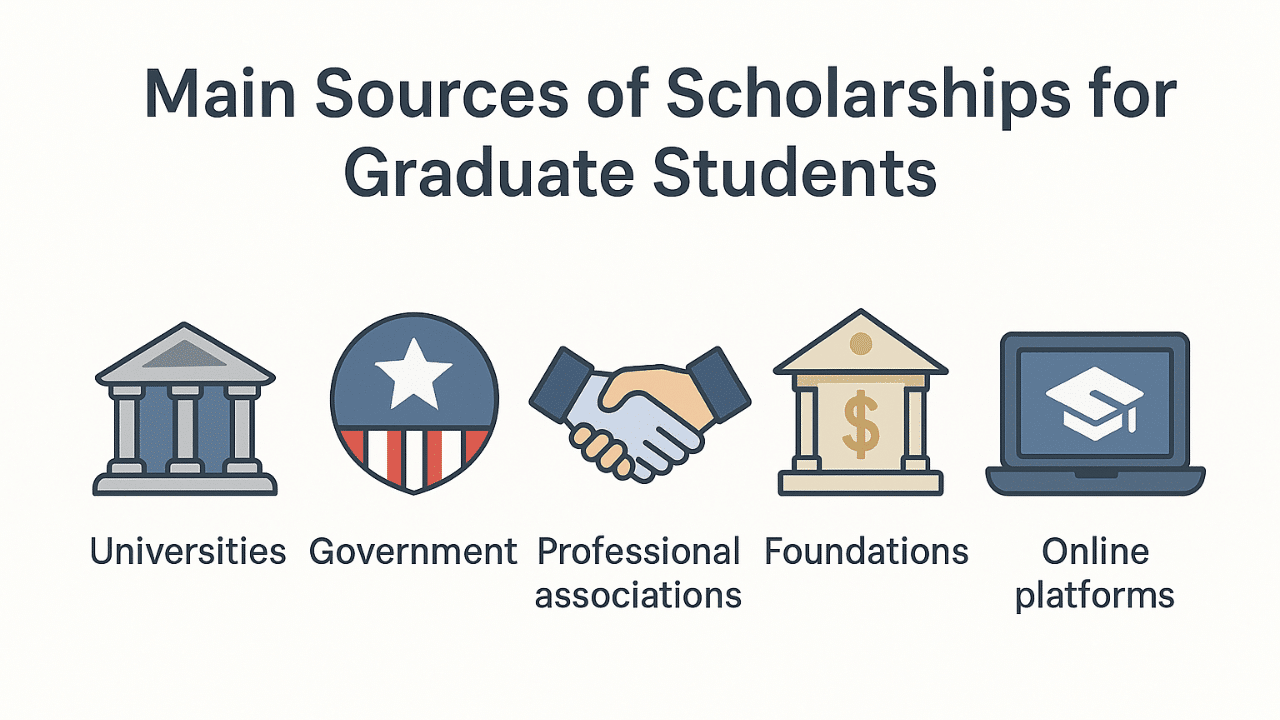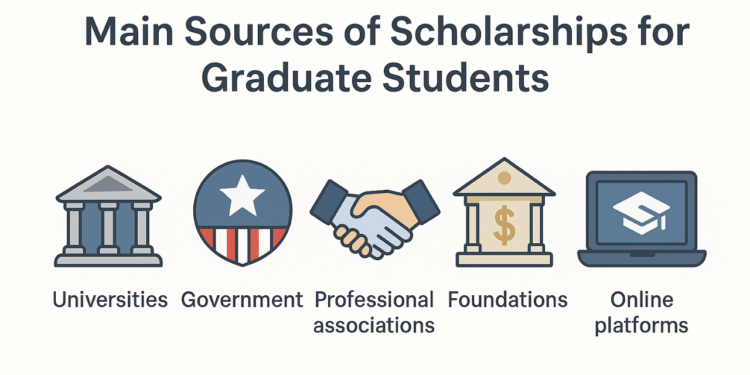Graduate school opens doors to better jobs, higher pay, and meaningful research, but it also comes with one of the biggest financial burdens students face. The average graduate borrower in the U.S. leaves school with around $70,000 in debt, often before landing a full-time position. Many students rely on loans by default, but scholarships and fellowships can be a smarter way to fund a degree.
Scholarships can prevent unnecessary debt, strengthen your resume, and give you more career options after graduation. This guide explains how to find scholarships that fit your goals, how to apply successfully, and how to combine multiple awards to make graduate school affordable.
And graduate school is costly. In the U.S., tuition averages $12,000–$30,000 per year, excluding living costs, research, and books (National Center for Education Statistics, 2023). The average graduate borrower leaves school with more than $70,000 in debt (Education Data Initiative, 2023).
Costs have steadily risen. A decade ago, average master’s tuition was closer to $9,000 per year; professional degrees like law and medicine have climbed even faster. While students often default to loans, scholarships and fellowships remain an underused but critical funding source.
This guide explains why scholarships matter, what types exist, where to find them, and how to apply strategically. You will also see how graduate students combine multiple awards to reduce costs.
Who this guide is for
Graduate students who want to:
- Fund a master’s, PhD, or professional degree without relying fully on loans
- Understand the range of scholarships and fellowships available
- Use a system for finding, tracking, and applying to awards
- Get step-by-step advice rather than generic lists
Why scholarships matter for graduate students
Scholarships come in many forms. Some reward academic performance or research success. Others focus on financial need, underrepresented backgrounds, or specific areas of study such as STEM, law, or public health. Knowing which type fits your situation helps you narrow your search and focus on the right applications.
- Reduce debt load: Directly cut into the $70,000 average graduate debt.
- Boost credibility: Competitive awards strengthen CVs and future applications.
- Create flexibility: Lower debt allows research, nonprofit, or academic career choices.
- Support equity: Many awards target first-generation, minority, or underrepresented students.
- Compound: Prior wins often increase odds of future funding.
Types of scholarships
Scholarships come in many forms. Some reward academic performance or research success. Others focus on financial need, underrepresented backgrounds, or specific areas of study such as STEM, law, or public health. Knowing which type fits your situation helps you narrow your search and focus on the right applications.
- Merit-based: Academic or research excellence
- Need-based: Linked to FAFSA or demonstrated hardship
- Field-specific: STEM, law, health, arts, education
- Diversity and inclusion: Women, first-generation, LGBTQ+, underrepresented groups
- Professional development: Travel, research, and conference funding
- Prestigious fellowships: Fulbright, Rhodes, NSF GRFP, Truman
What scholarships cover
Each scholarship has its own terms. Some pay full tuition, while others cover research costs, books, travel, or living expenses. Understanding what an award includes helps you plan a realistic budget and decide which opportunities to pursue. They can cover:
- Tuition and fees
- Books, research materials, software
- Conference travel and memberships
- Stipends or health insurance (common in fellowships)
Knowing what is and is not covered helps students budget realistically. For example, a $2,500 travel award will not erase tuition debt but may be the difference between presenting at a major conference or staying home.
Top sources for graduate scholarships
Reliable funding often comes from sources close to your field. Universities, government programs, professional associations, and nonprofit foundations all support graduate students. Starting your search early gives you more time to find and apply for the right options.
- Universities: Departmental awards, assistantships, dissertation fellowships
- Government: Fulbright, NSF GRFP, NIH training grants, state programs
- Associations: APA, IEEE, AMA, NASW, bar associations
- Foundations: Ford Foundation, Soros Fellowships, AAUW, Hispanic Scholarship Fund
- Databases: Scholarships360, Bold.org, Fastweb, Unigo, Scholarships.com

How to evaluate scholarship opportunities
Not every scholarship online is legitimate. Check that the program is tied to a real institution or foundation and that previous winners are listed publicly. Avoid any scholarship that asks for an application fee or personal information beyond what is standard. Students should:
- Check whether the award is linked to a university, nonprofit, or recognized foundation.
- Avoid programs that charge application fees.
- Verify past awardees through press releases or institutional websites.
This extra vetting avoids wasted time and protects personal information.
When awards matter most
Scholarship timing often matches your stage in school. Early in your degree, broad merit-based awards are common. Midway through, research and travel grants become more available. Toward the end, dissertation and completion fellowships can help you finish strong without financial pressure.
- Start of program: Broad merit scholarships, national fellowships
- Mid-program: Research and travel grants, association awards
- Final year: Dissertation or completion fellowships
- Professional degrees (MBA, JD, MD): School-specific and alumni-supported awards
Timing matters. A dissertation fellowship, for example, rarely applies in year one but can make the final year financially feasible.
How to apply successfully
A strong application requires planning. Read every instruction carefully, tailor your essay to the organization’s goals, and give recommenders time to write thoughtful letters. Keep a calendar of deadlines so that each submission is accurate and on time. Key practices include:
- Follow instructions exactly: Funders reject applications for simple errors like ignoring word limits.
- Tailor essays: Show how your goals align with the program’s mission. If the funder values community service, highlight leadership in that area.
- Get letters early: Strong recommendations come from faculty or supervisors with time to reflect, not last-minute requests.
- Reuse, but adapt: A personal statement on research passion can be recycled, but each application should highlight the aspects most relevant to that award.
- Track everything: Build a calendar of deadlines and requirements so no opportunity slips through.
Common mistakes
Students often lose out on scholarships for simple reasons. Generic essays, missed deadlines, and ignored local awards are all common issues. Smaller scholarships can add up quickly, but only if you apply.
- Applying only to big-name awards
- Missing deadlines due to disorganization
- Using generic essays that do not fit prompts
- Ignoring local or departmental awards
- Failing to track submissions
Many smaller awards ($1,000–$3,000) go unclaimed each year simply because students never apply.
Example outcomes
Real examples show how much difference scholarships can make. A few smaller awards can combine to pay for an entire semester. Travel grants can help students attend conferences that lead to collaborations and publications. Each award moves you closer to finishing your degree with less debt.
- A public health student applied to 12 scholarships, secured $18,000, and covered her final year. Her strongest essays tied her research to community impact.
- An engineering PhD candidate won a $2,500 travel grant that funded conference participation, which later led to a collaboration and journal article.
- An MBA student combined a foundation award and an alumni scholarship to cut tuition nearly in half. She applied mid-program, targeting scholarships specific to second-year students.
- A history MA student secured $3,500 from departmental and local awards. Careful timing allowed him to spend two months abroad completing archival research that supported his thesis.
These anonymized cases show how stacking smaller awards can transform graduate school affordability.
Step-by-step workflow for graduate scholarships
Organization makes the process easier. Keep a single spreadsheet for deadlines, essays, and references. Start drafts early, get feedback, and track results so you can reapply or renew when possible. A clear system turns a stressful process into a manageable routine.
- Collect opportunities: Start with university databases, association websites, and national platforms. Maintain a single spreadsheet or tracking tool.
- Build a story bank: Gather examples of leadership, research, teaching, and service. Categorize them so you can pull the right story for each application.
- Record deadlines and requirements: Include word counts, essay prompts, and reference needs. Avoid relying on memory.
- Draft early: Begin essays weeks in advance to allow for faculty feedback and revision.
- Submit and confirm: Save proof of submission in case of disputes.
- Track outcomes: Note wins, rejections, and pending results. Reapply to renewable awards whenever possible.
This approach prevents missed opportunities and turns a chaotic process into a repeatable system.
Frequently asked questions
Can you get a full scholarship for a master’s degree?
Yes. Fellowships and assistantships can cover tuition and living costs, particularly in STEM, education, and international programs.
Do international students qualify?
Yes. Fulbright, DAAD, Chevening, Rotary, and other programs target international applicants.
What GPA is required?
There is no universal GPA cutoff. Some fellowships and merit-based awards expect a strong academic record (often 3.0–3.5+), but many scholarships focus on financial need, field of study, leadership, or service. Plenty of awards are granted regardless of GPA, so students should not self-exclude based on grades alone.
How competitive are scholarships?
It varies widely. Prestigious fellowships may accept fewer than 10% of applicants, while smaller association or local awards may fund 30–40%.
Can you reapply after rejection?
Often yes. Many associations and universities encourage reapplication in later years, especially if you strengthen your CV or essay.
Resources you can use today
- Fulbright U.S. Student Program
- NSF Graduate Research Fellowship Program
- Ford Foundation Fellowship
- Scholarships360 Graduate Scholarships List
- TheGradCafe Scholarship Forum Threads
- Lenny.ai for verified scholarships and deadline tracking
Conclusion
Graduate scholarships can change the financial reality of higher education. They are more common than many students realize, but success depends on consistency and organization. The students who secure the most funding are usually the ones who start early, apply often, and keep their materials ready to adapt for each opportunity.
By learning where to look, tailoring your essays, and tracking your applications, you can turn scattered chances into a structured plan for funding your education. Every scholarship, no matter the size, reduces the need for loans and gives you more control over your academic path.
Graduate school will always require hard work, but paying for it does not have to mean a lifetime of debt. With the right approach, scholarships and fellowships can make a degree affordable and open the door to the career you want.
Kenny Sandorffyis the founder ScholarshipOwl, Lenni.AI, and Berti.Ai, platforms that help students discover verified scholarships, stay organized, and meet deadlines with confidence.








